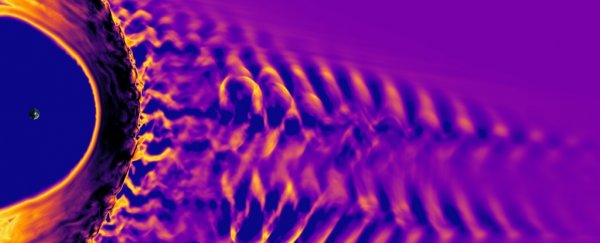In space, no one can hear you scream because sound can't travel in a vacuum. But if we convert electromagnetic activity to sound, it suddenly becomes a very noisy place. And our Earth is no exception; specifically, in and around the magnetic field generated by Earth's molten core.
This barrier, called a magnetosphere, is thought to be one of the vital ingredients for a life-supporting planet, protecting us from the harsh radiation of the solar wind. And the stronger the wind, the louder the magnetosphere sings.
As charged particles from the solar wind stream towards the magnetosphere, some are reflected from the shock region in front of the magnetic field back towards the Sun. This 'backsplash' then interacts with the solar wind that's still streaming in, generating instabilities in the plasma and resulting in magnetoacoustic waves.
Scientists on Earth then translate these magnetoacoustic waves into sound - strange chirps and whistles - to understand the dynamics of interactions between the solar wind and the magnetosphere.
Now, for the first time, the song of Earth and Sun has been recorded during a solar storm, when the solar wind blows at its most wild and fierce out into space.
Four Earth-orbiting spacecraft collectively known as the Cluster mission, conducted by the European Space Agency, sampled six solar storms from the foreshock - the region upstream of Earth's bow shock, where the solar wind first lashes up against Earth's magnetosphere.
Audio files of those electromagnetic waves reveal that the waves in the magnetosphere created by a solar storm are much more complex than previously thought.
"Our study reveals that solar storms profoundly modify the foreshock region," said physicist Lucile Turc of the University of Helsinki in Finland, who led an international team of researchers. "It's like the storm is changing the tuning of the foreshock."
As you'll hear in the video below, the magnetosphere is never quiet. Particles and radiation are always flowing from the Sun, which produces a certain level of calm solar weather chirruping.
During a solar storm - when a large-scale magnetic eruption takes place on the surface of the Sun, sending charged particles hurtling into space (and, if it hits Earth, often producing really pretty auroras) - things get a lot more dramatic.
During normal calm weather, the magnetosphere produces low-frequency waves, dominated by a single frequency. During a solar storm, the pressure of the solar wind pushing the frequency of the waves gets much higher. In addition, a number of these higher frequency waves are superposed in a complex network, rather than just one dominating frequency.
"We always expected a change in frequency, but not the level of complexity in the wave," Turc noted.
The bow shock, between the magnetosphere and the foreshock, is an additional barrier between the waves and Earth, but we know the waves don't bounce back towards the Sun - there's too much pressure from the solar wind.
Rather, these changes to the foreshock are propagated all the way down to Earth's surface in a matter of minutes; or they can trigger fast jets in the magnetosheath that cause geomagnetic disturbances, which in turn can impact communications and navigation equipment, and electrical systems
Turc and her team are now working to try and understand how these complex wave superpositions are generated.
The research has been published in Geophysical Research Letters.
